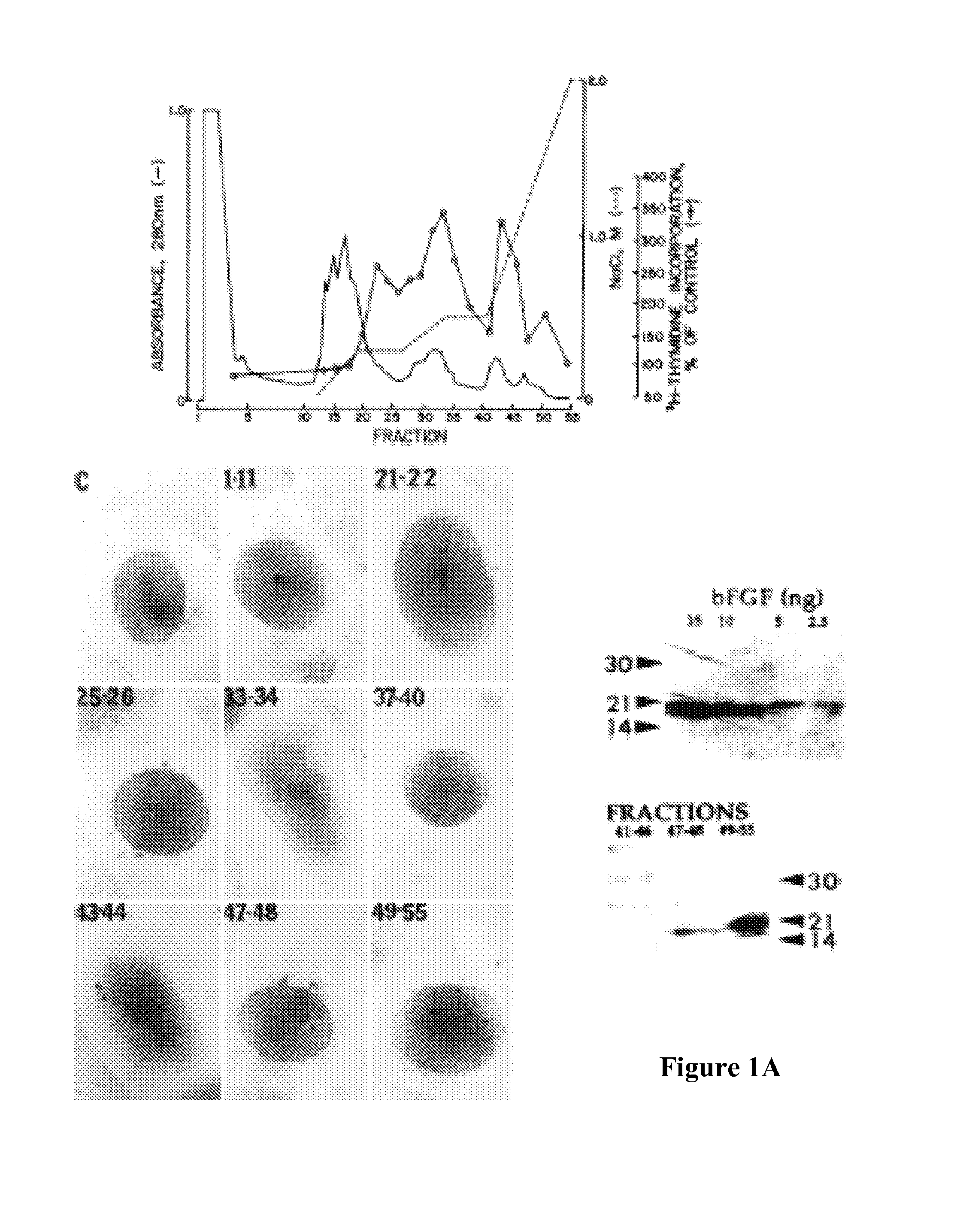Compositions for modulating growth of embryonic and adult kidney tissue and uses for treating kidney damage
a technology of kidney tissue and growth factors, which is applied in the direction of osteogenic factor, peptide/protein ingredient, anti-noxious agent, etc., can solve the problem of no known specific therapy
- Summary
- Abstract
- Description
- Claims
- Application Information
AI Technical Summary
Benefits of technology
Problems solved by technology
Method used
Image
Examples
example 1
Function of FGFs and TIMPs in Conversion and Maintenance of Mesenchymal Cells
[0098] Metanephric mesenchyme dies when separated from the ureteric bud, but it undergoes extensive growth for days-weeks in culture when treated with UB proteins. This allows the mesenchyme to be cultured in serum free conditions. By protein purification, FGF-2 and FGF-9 were identified as active stimuli (FIGS. 1A-1B). Screening ureteric bud RNA with Affymetrix gene chips also showed that FGF-18 is specific to the ureteric bud and induces growth of the mesenchyme (Sakurai et al., Proc Natl Acad Sci USA 94:6279-6284 (1997)). Co-expression of these FGFs is common to other organs.
[0099] To determine if FGFs stimulate cell conversion, metanephric mesenchyme was grown for a number of days with FGF-2 but cells did not convert to epithelium, even using RT-PCR to assay for epithelial proteins (Barasch et al., Am J Physiol 271(1 Pt 2):F50-F61 (1996)). To determine if FGF-2-grown mesenchyme contained competent epi...
example 2
Mesenchymal to Epithelial Conversion in rat Metanephros is Induced by LIF
[0101] In experiments where spinal cord fragments are used as a source of metanephric-inducing molecules, epithelialization requires a ‘second’ stimulus to induce mesenchymal conversion. To identify whether the ureteric bud produces this second signal, rat mesenchyme was incubated with FGF-2 and then added UB proteins (Barasch et al., Cell 99:377-386 (1999)). The combination induced hundreds of cysts, tubules and early nephrons (FIG. 3). The conversion was reproduced in every mesenchyme (n>1000), and was visible to the naked eye, allowing rapid screening of chromatographic fractions. Leukemia inhibitory factor (LIF) was purified as the kidney inducer. Recombinant LIF was also inductive; its inductive activity was synergistic with TGFβ2.
[0102] The tubules produced by LIF were characterized. There were many C-shaped bodies (early nephron precursors) which expressed E-cadherin at one pole (the future distal conv...
example 3
An Epithelial Precursor is Regulated by the Ureteric Bud and by the Renal Stroma
[0106] The clusters of Pax-2, WT-1, and Wnt-4 cells never expressed epithelial proteins (even after prolonged culture), but within 24 hours of adding LIF, they expressed many epithelial proteins such as E-cadherin, ZO-1 and lamininα5 (Yang et al., Dev Biol 246:296-310 (2002)). Over a 4-day period, these cells aggregated and formed tubules and nephrons. This sequence of events showed that LIF targeted late staged mesenchymal cells (i.e. Wnt-4+ cells) triggering the expression of epithelial proteins.
[0107] To determine whether the Pax-2+, WT-1+, Wnt-4+ clusters could be induced in the absence of other types of mesenchymal cells, the clusters were isolated with a needle and LIF and FGF-2 were then added. This activated a variety of relevant second messengers (STAT-3, STAT dependent SOCS and CIS genes), followed by growth of these cells and glomerulo-tubulogenesis (FIGS. 7A-7E). This shows that signaling f...
PUM
| Property | Measurement | Unit |
|---|---|---|
| Mass | aaaaa | aaaaa |
| Mass | aaaaa | aaaaa |
| Digital information | aaaaa | aaaaa |
Abstract
Description
Claims
Application Information
 Login to View More
Login to View More - R&D
- Intellectual Property
- Life Sciences
- Materials
- Tech Scout
- Unparalleled Data Quality
- Higher Quality Content
- 60% Fewer Hallucinations
Browse by: Latest US Patents, China's latest patents, Technical Efficacy Thesaurus, Application Domain, Technology Topic, Popular Technical Reports.
© 2025 PatSnap. All rights reserved.Legal|Privacy policy|Modern Slavery Act Transparency Statement|Sitemap|About US| Contact US: help@patsnap.com



